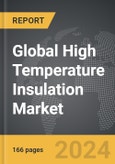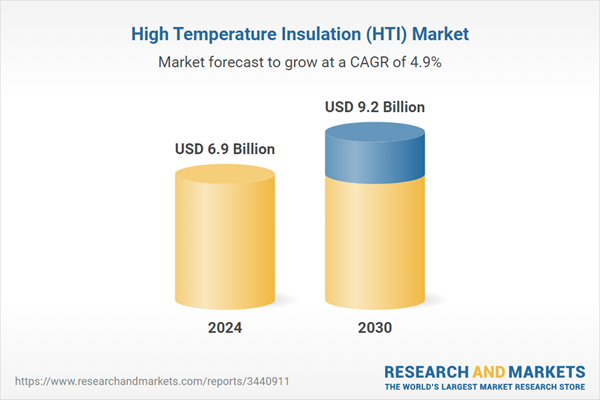The global market for High Temperature Insulation (HTI) was valued at US$6.9 Billion in 2024 and is projected to reach US$9.2 Billion by 2030, growing at a CAGR of 4.9% from 2024 to 2030. This comprehensive report provides an in-depth analysis of market trends, drivers, and forecasts, helping you make informed business decisions. The report includes the most recent global tariff developments and how they impact the High Temperature Insulation (HTI) market.
Ceramic-impregnated fabrics mark a significant advancement in insulation technology, offering enhanced properties by embedding nano-bioceramics into fabrics through methods like electrophoretic deposition. This process involves coating ceramic particles onto the fabric in a heated solution, enhancing the fabric’s ability to emit light in the far-infrared spectrum when heated. These high-performance fabrics are employed across various sectors, benefitting from their ability to withstand high temperatures without deforming, proving invaluable in demanding environments. Meanwhile, glass wool, made from fibrous glass and developed in the 1930s, serves as an excellent insulator in building applications, trapping air within fibers to reduce heat transfer through convection. This material is used in various forms including rolls, batts, and sprays for thermal and acoustic insulation, demonstrating its versatility across different settings.
The market growth for HTI materials is influenced by a variety of factors. Increasing energy costs and stringent energy efficiency regulations drive industries toward advanced thermal management solutions that reduce energy loss and enhance process efficiency. Environmental compliance regarding greenhouse gas emissions also propels the adoption of HTI materials to improve energy usage and reduce industrial carbon footprints. The expansion of industries that operate at high temperatures - such as aerospace, automotive, and manufacturing - further drives demand for effective HTI materials essential for equipment protection and energy cost reduction. Technological advances in manufacturing processes and integration with other advanced technologies like IoT enhance the functionality and application of HTI materials, making them integral to modern industrial operations. Additionally, global industrialization, urbanization, and the push for sustainable practices underscore the increasing need for these materials, which are essential for managing extreme conditions and improving efficiency in a variety of industrial and construction contexts.
Segments: Product (Ceramic Fibers, Insulating Firebrick, Calcium Silicate, Other Products); Application (Petrochemicals, Ceramics, Glass, Cement, Iron & Steel, Aluminum, Other Applications).
Geographic Regions/Countries: World; United States; Canada; Japan; China; Europe (France; Germany; Italy; United Kingdom; Spain; Russia; and Rest of Europe); Asia-Pacific (Australia; India; South Korea; and Rest of Asia-Pacific); Latin America (Argentina; Brazil; Mexico; and Rest of Latin America); Middle East (Iran; Israel; Saudi Arabia; United Arab Emirates; and Rest of Middle East); and Africa.
The analysts continuously track trade developments worldwide, drawing insights from leading global economists and over 200 industry and policy institutions, including think tanks, trade organizations, and national economic advisory bodies. This intelligence is integrated into forecasting models to provide timely, data-driven analysis of emerging risks and opportunities.
Global High Temperature Insulation (HTI) Market - Key Trends and Drivers Summarized
High temperature insulation (HTI) materials are crucial for various industrial applications, particularly those involving high heat processes such as metal melting and heat treatment. Over the years, developments in HTI materials have evolved from traditional solutions like refractory bricks and clinkers to more advanced synthetic options such as glass wool and rock wool, effective up to about 500°C. In the 1960s, refractory ceramic fibers based on aluminosilicate were introduced, quickly setting a new standard for HTI due to their excellent thermal shock resistance and low thermal conductivity. Today's innovations in HTI include ceramic-impregnated fabrics and advances in glass wool technology, showcasing ongoing development in this field crucial for a broad range of applications from aerospace components like exit cones and door seals to electronics and industrial settings like furnace linings and pipe seals.Ceramic-impregnated fabrics mark a significant advancement in insulation technology, offering enhanced properties by embedding nano-bioceramics into fabrics through methods like electrophoretic deposition. This process involves coating ceramic particles onto the fabric in a heated solution, enhancing the fabric’s ability to emit light in the far-infrared spectrum when heated. These high-performance fabrics are employed across various sectors, benefitting from their ability to withstand high temperatures without deforming, proving invaluable in demanding environments. Meanwhile, glass wool, made from fibrous glass and developed in the 1930s, serves as an excellent insulator in building applications, trapping air within fibers to reduce heat transfer through convection. This material is used in various forms including rolls, batts, and sprays for thermal and acoustic insulation, demonstrating its versatility across different settings.
The market growth for HTI materials is influenced by a variety of factors. Increasing energy costs and stringent energy efficiency regulations drive industries toward advanced thermal management solutions that reduce energy loss and enhance process efficiency. Environmental compliance regarding greenhouse gas emissions also propels the adoption of HTI materials to improve energy usage and reduce industrial carbon footprints. The expansion of industries that operate at high temperatures - such as aerospace, automotive, and manufacturing - further drives demand for effective HTI materials essential for equipment protection and energy cost reduction. Technological advances in manufacturing processes and integration with other advanced technologies like IoT enhance the functionality and application of HTI materials, making them integral to modern industrial operations. Additionally, global industrialization, urbanization, and the push for sustainable practices underscore the increasing need for these materials, which are essential for managing extreme conditions and improving efficiency in a variety of industrial and construction contexts.
Report Scope
The report analyzes the High Temperature Insulation (HTI) market, presented in terms of units. The analysis covers the key segments and geographic regions outlined below.Segments: Product (Ceramic Fibers, Insulating Firebrick, Calcium Silicate, Other Products); Application (Petrochemicals, Ceramics, Glass, Cement, Iron & Steel, Aluminum, Other Applications).
Geographic Regions/Countries: World; United States; Canada; Japan; China; Europe (France; Germany; Italy; United Kingdom; Spain; Russia; and Rest of Europe); Asia-Pacific (Australia; India; South Korea; and Rest of Asia-Pacific); Latin America (Argentina; Brazil; Mexico; and Rest of Latin America); Middle East (Iran; Israel; Saudi Arabia; United Arab Emirates; and Rest of Middle East); and Africa.
Key Insights:
- Market Growth: Understand the significant growth trajectory of the Ceramic Fibers segment, which is expected to reach US$6.1 Billion by 2030 with a CAGR of a 5.2%. The Insulating Firebrick segment is also set to grow at 4.6% CAGR over the analysis period.
- Regional Analysis: Gain insights into the U.S. market, valued at $1.8 Billion in 2024, and China, forecasted to grow at an impressive 8.3% CAGR to reach $2.0 Billion by 2030. Discover growth trends in other key regions, including Japan, Canada, Germany, and the Asia-Pacific.
Why You Should Buy This Report:
- Detailed Market Analysis: Access a thorough analysis of the Global High Temperature Insulation (HTI) Market, covering all major geographic regions and market segments.
- Competitive Insights: Get an overview of the competitive landscape, including the market presence of major players across different geographies.
- Future Trends and Drivers: Understand the key trends and drivers shaping the future of the Global High Temperature Insulation (HTI) Market.
- Actionable Insights: Benefit from actionable insights that can help you identify new revenue opportunities and make strategic business decisions.
Key Questions Answered:
- How is the Global High Temperature Insulation (HTI) Market expected to evolve by 2030?
- What are the main drivers and restraints affecting the market?
- Which market segments will grow the most over the forecast period?
- How will market shares for different regions and segments change by 2030?
- Who are the leading players in the market, and what are their prospects?
Report Features:
- Comprehensive Market Data: Independent analysis of annual sales and market forecasts in US$ Million from 2024 to 2030.
- In-Depth Regional Analysis: Detailed insights into key markets, including the U.S., China, Japan, Canada, Europe, Asia-Pacific, Latin America, Middle East, and Africa.
- Company Profiles: Coverage of players such as 3M Company, ADL Insulflex, Inc., Almatis B.V., Global Cellular, Inc., Hi-Temp Insulation, Inc. and more.
- Complimentary Updates: Receive free report updates for one year to keep you informed of the latest market developments.
Some of the 27 companies featured in this High Temperature Insulation (HTI) market report include:
- 3M Company
- ADL Insulflex, Inc.
- Almatis B.V.
- Global Cellular, Inc.
- Hi-Temp Insulation, Inc.
- Insulcon BV
- Isolite Insulating Products Co., Ltd.
- Morgan Advanced Materials plc
- Pacor, Inc.
- Promat International SA
- Pyrotek Incorporated
- Skamol A/S
- Zircar Zirconia, Inc.
Tariff Impact Analysis: Key Insights for 2025
Global tariff negotiations across 180+ countries are reshaping supply chains, costs, and competitiveness. This report reflects the latest developments as of April 2025 and incorporates forward-looking insights into the market outlook.The analysts continuously track trade developments worldwide, drawing insights from leading global economists and over 200 industry and policy institutions, including think tanks, trade organizations, and national economic advisory bodies. This intelligence is integrated into forecasting models to provide timely, data-driven analysis of emerging risks and opportunities.
What’s Included in This Edition:
- Tariff-adjusted market forecasts by region and segment
- Analysis of cost and supply chain implications by sourcing and trade exposure
- Strategic insights into geographic shifts
Buyers receive a free July 2025 update with:
- Finalized tariff impacts and new trade agreement effects
- Updated projections reflecting global sourcing and cost shifts
- Expanded country-specific coverage across the industry
Table of Contents
I. METHODOLOGYII. EXECUTIVE SUMMARY2. FOCUS ON SELECT PLAYERSIII. MARKET ANALYSISCANADAITALYSPAINRUSSIAREST OF EUROPESOUTH KOREAREST OF ASIA-PACIFICARGENTINABRAZILMEXICOREST OF LATIN AMERICAIRANISRAELSAUDI ARABIAUNITED ARAB EMIRATESREST OF MIDDLE EASTIV. COMPETITION
1. MARKET OVERVIEW
3. MARKET TRENDS & DRIVERS
4. GLOBAL MARKET PERSPECTIVE
UNITED STATES
JAPAN
CHINA
EUROPE
FRANCE
GERMANY
UNITED KINGDOM
ASIA-PACIFIC
AUSTRALIA
INDIA
LATIN AMERICA
MIDDLE EAST
AFRICA
Companies Mentioned (Partial List)
A selection of companies mentioned in this report includes, but is not limited to:
- 3M Company
- ADL Insulflex, Inc.
- Almatis B.V.
- Global Cellular, Inc.
- Hi-Temp Insulation, Inc.
- Insulcon BV
- Isolite Insulating Products Co., Ltd.
- Morgan Advanced Materials plc
- Pacor, Inc.
- Promat International SA
- Pyrotek Incorporated
- Skamol A/S
- Zircar Zirconia, Inc.
Table Information
| Report Attribute | Details |
|---|---|
| No. of Pages | 166 |
| Published | April 2025 |
| Forecast Period | 2024 - 2030 |
| Estimated Market Value ( USD | $ 6.9 Billion |
| Forecasted Market Value ( USD | $ 9.2 Billion |
| Compound Annual Growth Rate | 4.9% |
| Regions Covered | Global |









